Research Proposal: Construction Project Cost Factors in Australia
VerifiedAdded on 2023/03/31
|16
|3532
|290
Project
AI Summary
This research proposal investigates the factors influencing the cost of building construction projects in Australia, recognizing the increasing cost concerns in the construction sector. The study aims to determine the influence of project planning, rework costs, contractor competency, and project management on construction costs. The proposal justifies the research's importance due to rising costs and a gap in existing literature, aiming to provide insights for organizations and future studies. The proposal includes a conceptual framework exploring the impact of rework and other factors. The methodology will involve data collection and research design, including a sampling method to address the research questions. The project explores the increasing costs in the construction sector in Australia.
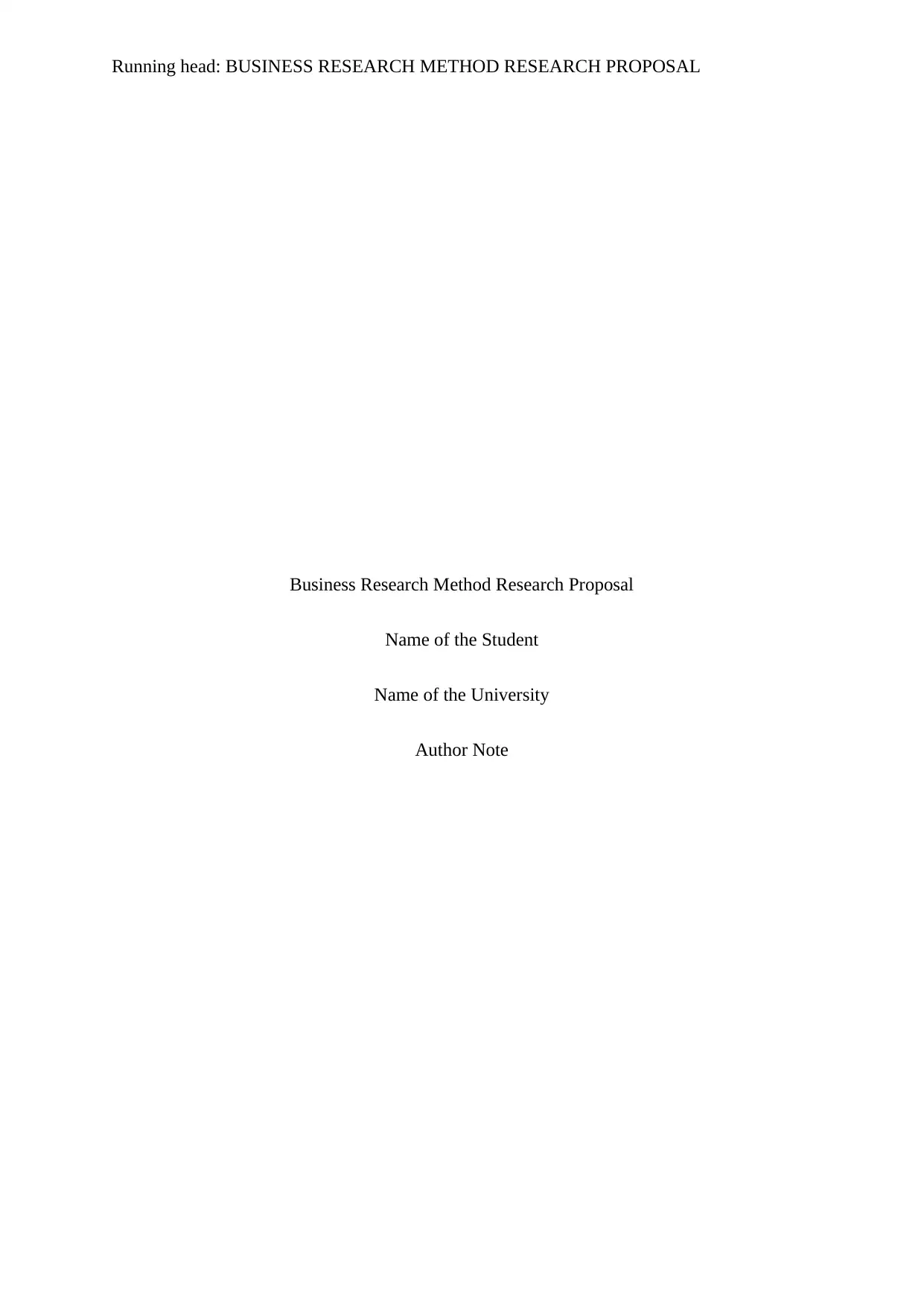
Running head: BUSINESS RESEARCH METHOD RESEARCH PROPOSAL
Business Research Method Research Proposal
Name of the Student
Name of the University
Author Note
Business Research Method Research Proposal
Name of the Student
Name of the University
Author Note
Paraphrase This Document
Need a fresh take? Get an instant paraphrase of this document with our AI Paraphraser
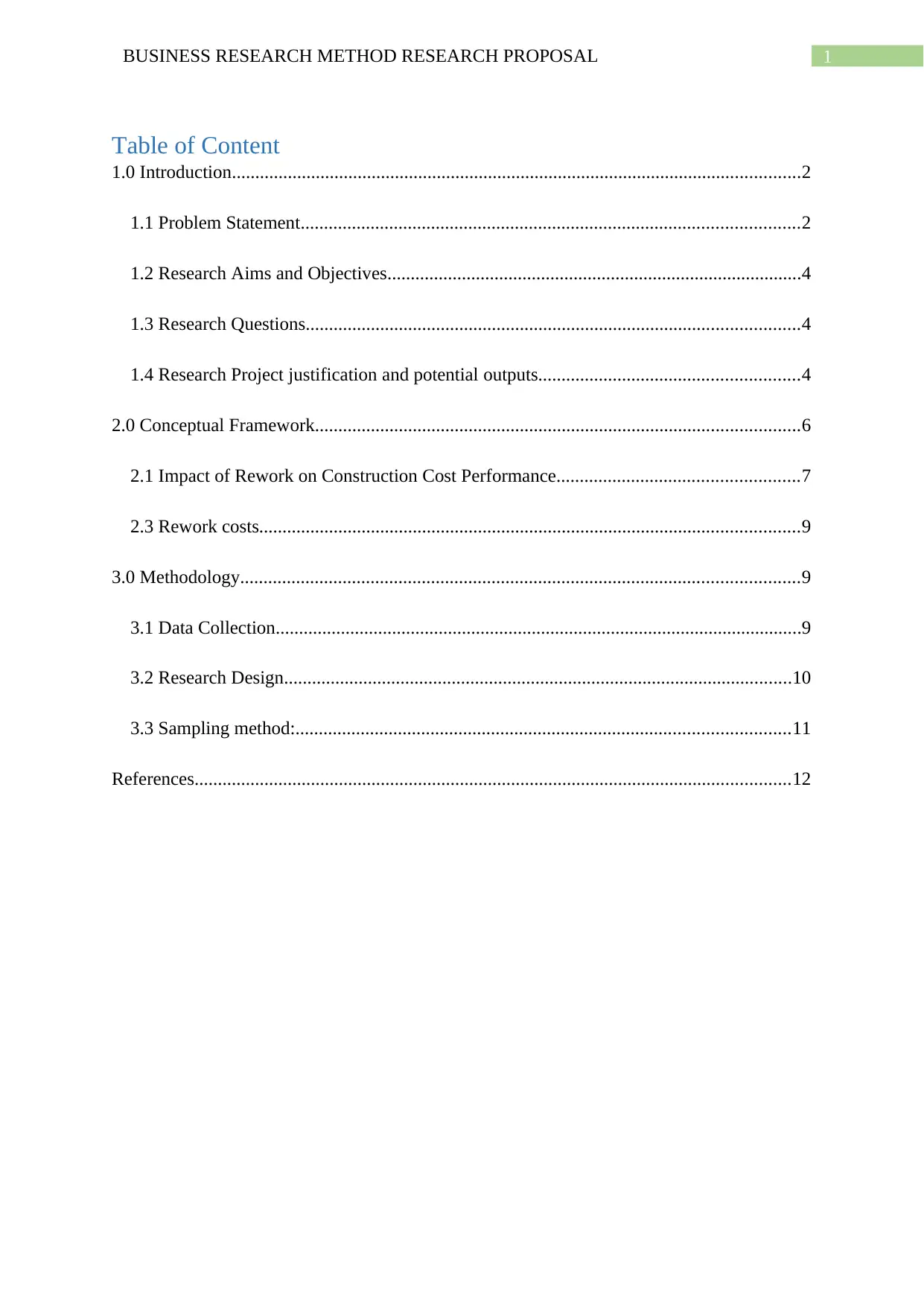
1BUSINESS RESEARCH METHOD RESEARCH PROPOSAL
Table of Content
1.0 Introduction..........................................................................................................................2
1.1 Problem Statement...........................................................................................................2
1.2 Research Aims and Objectives.........................................................................................4
1.3 Research Questions..........................................................................................................4
1.4 Research Project justification and potential outputs........................................................4
2.0 Conceptual Framework........................................................................................................6
2.1 Impact of Rework on Construction Cost Performance....................................................7
2.3 Rework costs....................................................................................................................9
3.0 Methodology........................................................................................................................9
3.1 Data Collection.................................................................................................................9
3.2 Research Design.............................................................................................................10
3.3 Sampling method:..........................................................................................................11
References................................................................................................................................12
Table of Content
1.0 Introduction..........................................................................................................................2
1.1 Problem Statement...........................................................................................................2
1.2 Research Aims and Objectives.........................................................................................4
1.3 Research Questions..........................................................................................................4
1.4 Research Project justification and potential outputs........................................................4
2.0 Conceptual Framework........................................................................................................6
2.1 Impact of Rework on Construction Cost Performance....................................................7
2.3 Rework costs....................................................................................................................9
3.0 Methodology........................................................................................................................9
3.1 Data Collection.................................................................................................................9
3.2 Research Design.............................................................................................................10
3.3 Sampling method:..........................................................................................................11
References................................................................................................................................12
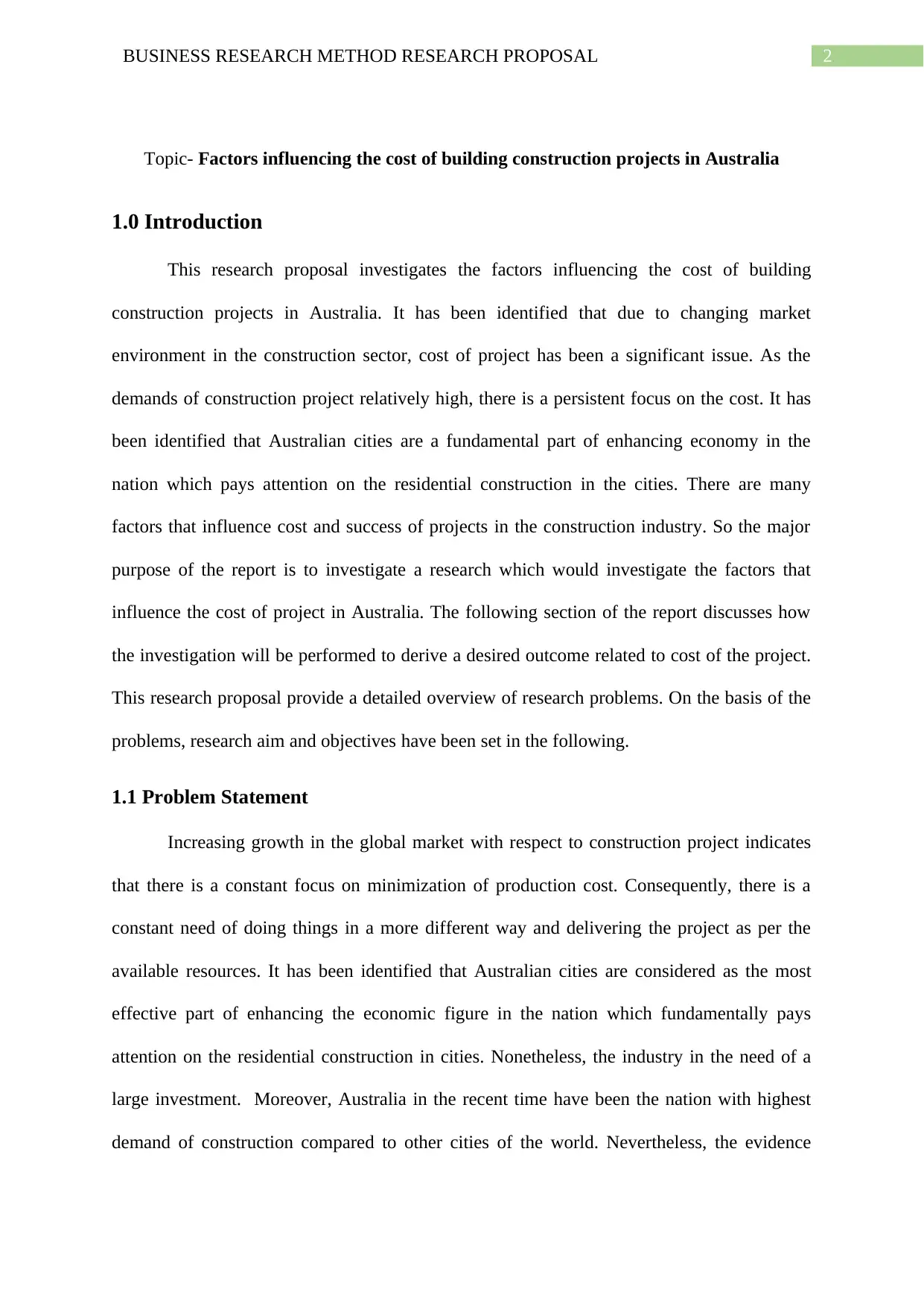
2BUSINESS RESEARCH METHOD RESEARCH PROPOSAL
Topic- Factors influencing the cost of building construction projects in Australia
1.0 Introduction
This research proposal investigates the factors influencing the cost of building
construction projects in Australia. It has been identified that due to changing market
environment in the construction sector, cost of project has been a significant issue. As the
demands of construction project relatively high, there is a persistent focus on the cost. It has
been identified that Australian cities are a fundamental part of enhancing economy in the
nation which pays attention on the residential construction in the cities. There are many
factors that influence cost and success of projects in the construction industry. So the major
purpose of the report is to investigate a research which would investigate the factors that
influence the cost of project in Australia. The following section of the report discusses how
the investigation will be performed to derive a desired outcome related to cost of the project.
This research proposal provide a detailed overview of research problems. On the basis of the
problems, research aim and objectives have been set in the following.
1.1 Problem Statement
Increasing growth in the global market with respect to construction project indicates
that there is a constant focus on minimization of production cost. Consequently, there is a
constant need of doing things in a more different way and delivering the project as per the
available resources. It has been identified that Australian cities are considered as the most
effective part of enhancing the economic figure in the nation which fundamentally pays
attention on the residential construction in cities. Nonetheless, the industry in the need of a
large investment. Moreover, Australia in the recent time have been the nation with highest
demand of construction compared to other cities of the world. Nevertheless, the evidence
Topic- Factors influencing the cost of building construction projects in Australia
1.0 Introduction
This research proposal investigates the factors influencing the cost of building
construction projects in Australia. It has been identified that due to changing market
environment in the construction sector, cost of project has been a significant issue. As the
demands of construction project relatively high, there is a persistent focus on the cost. It has
been identified that Australian cities are a fundamental part of enhancing economy in the
nation which pays attention on the residential construction in the cities. There are many
factors that influence cost and success of projects in the construction industry. So the major
purpose of the report is to investigate a research which would investigate the factors that
influence the cost of project in Australia. The following section of the report discusses how
the investigation will be performed to derive a desired outcome related to cost of the project.
This research proposal provide a detailed overview of research problems. On the basis of the
problems, research aim and objectives have been set in the following.
1.1 Problem Statement
Increasing growth in the global market with respect to construction project indicates
that there is a constant focus on minimization of production cost. Consequently, there is a
constant need of doing things in a more different way and delivering the project as per the
available resources. It has been identified that Australian cities are considered as the most
effective part of enhancing the economic figure in the nation which fundamentally pays
attention on the residential construction in cities. Nonetheless, the industry in the need of a
large investment. Moreover, Australia in the recent time have been the nation with highest
demand of construction compared to other cities of the world. Nevertheless, the evidence
⊘ This is a preview!⊘
Do you want full access?
Subscribe today to unlock all pages.

Trusted by 1+ million students worldwide

3BUSINESS RESEARCH METHOD RESEARCH PROPOSAL
related to cost of construction in the nation is considered to be conflicting. Moreover, in some
areas, it is found that cost of construction project has been found to be higher than the other
regions. This creates the concern about the resolution which would help to resolve the issues.
It has been identified that the expense of projects is a significant concern as they
determine whether the project could gain success (Cantarelli et al., 2013). Hence, some
major factors are responsible for the cost of major construction projects and some of these
factors include interest, costs, taxation arrangement, and cost of transport as well as
concession of tariff. Even though, many studies have been performed to investigate this issue
but plenty of time elapsed to identify the need of performing another study that influence the
cost of developing construction project in Australia. Taroun (2014) mentioned that cost
overrun in Australian construction project remain unclear for long period, even a mere
resolution to this problem took a lot of time to be revealed. Furthermore, Hwang, Zhao and
Gay (2013) performed a study and cost of total rework in the construction project in Australia
stated that organization in the construction industry were not aware of the cost of rework.
Consequently, estimates found by some respondents were more of subjective
evaluation as well as individual knowledge of respondents on projects. On the contrary,
Hwang, Zhao and Gay (2013) mentioned that overall cost of rework could differ significantly
but it entirely depends on the project. An extent of the variability in project estimates has
effectively disclosed the construction professional are lacking knowledge regarding the cost
of rework that are certainly incurred in the some particular project. Studies have revealed that
renovation and refurbishment projects are most likely to be higher compared to the cost of
rework compared to the new building projects. Even though the existing papers delivered
some significant insight on factors that influence the cost of construction projects, some of
the scholars paid attention to construction projects generally, therefore there is a constant
need of bridging the gap and undertaking a research that pays attention to development of
related to cost of construction in the nation is considered to be conflicting. Moreover, in some
areas, it is found that cost of construction project has been found to be higher than the other
regions. This creates the concern about the resolution which would help to resolve the issues.
It has been identified that the expense of projects is a significant concern as they
determine whether the project could gain success (Cantarelli et al., 2013). Hence, some
major factors are responsible for the cost of major construction projects and some of these
factors include interest, costs, taxation arrangement, and cost of transport as well as
concession of tariff. Even though, many studies have been performed to investigate this issue
but plenty of time elapsed to identify the need of performing another study that influence the
cost of developing construction project in Australia. Taroun (2014) mentioned that cost
overrun in Australian construction project remain unclear for long period, even a mere
resolution to this problem took a lot of time to be revealed. Furthermore, Hwang, Zhao and
Gay (2013) performed a study and cost of total rework in the construction project in Australia
stated that organization in the construction industry were not aware of the cost of rework.
Consequently, estimates found by some respondents were more of subjective
evaluation as well as individual knowledge of respondents on projects. On the contrary,
Hwang, Zhao and Gay (2013) mentioned that overall cost of rework could differ significantly
but it entirely depends on the project. An extent of the variability in project estimates has
effectively disclosed the construction professional are lacking knowledge regarding the cost
of rework that are certainly incurred in the some particular project. Studies have revealed that
renovation and refurbishment projects are most likely to be higher compared to the cost of
rework compared to the new building projects. Even though the existing papers delivered
some significant insight on factors that influence the cost of construction projects, some of
the scholars paid attention to construction projects generally, therefore there is a constant
need of bridging the gap and undertaking a research that pays attention to development of
Paraphrase This Document
Need a fresh take? Get an instant paraphrase of this document with our AI Paraphraser
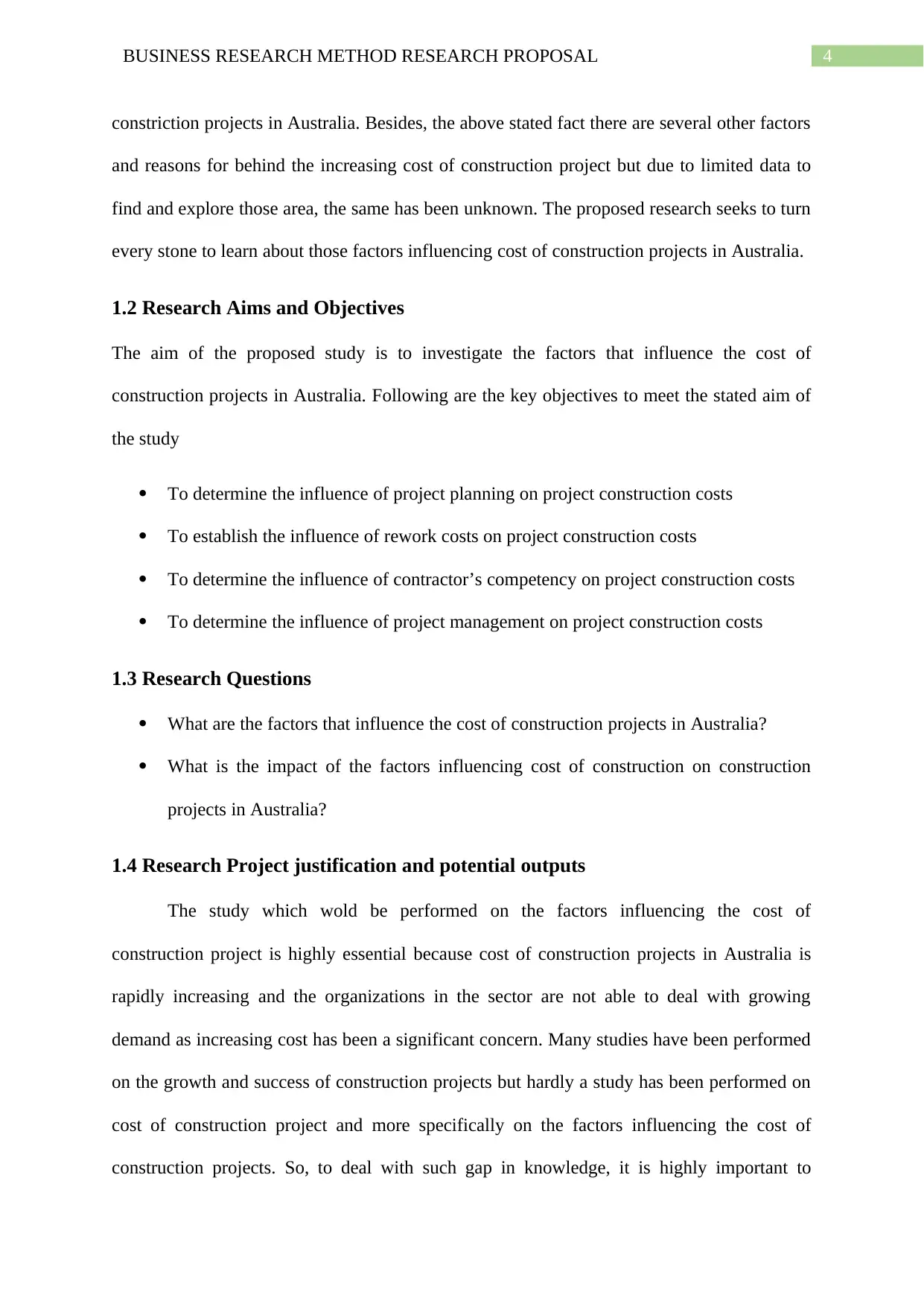
4BUSINESS RESEARCH METHOD RESEARCH PROPOSAL
constriction projects in Australia. Besides, the above stated fact there are several other factors
and reasons for behind the increasing cost of construction project but due to limited data to
find and explore those area, the same has been unknown. The proposed research seeks to turn
every stone to learn about those factors influencing cost of construction projects in Australia.
1.2 Research Aims and Objectives
The aim of the proposed study is to investigate the factors that influence the cost of
construction projects in Australia. Following are the key objectives to meet the stated aim of
the study
To determine the influence of project planning on project construction costs
To establish the influence of rework costs on project construction costs
To determine the influence of contractor’s competency on project construction costs
To determine the influence of project management on project construction costs
1.3 Research Questions
What are the factors that influence the cost of construction projects in Australia?
What is the impact of the factors influencing cost of construction on construction
projects in Australia?
1.4 Research Project justification and potential outputs
The study which wold be performed on the factors influencing the cost of
construction project is highly essential because cost of construction projects in Australia is
rapidly increasing and the organizations in the sector are not able to deal with growing
demand as increasing cost has been a significant concern. Many studies have been performed
on the growth and success of construction projects but hardly a study has been performed on
cost of construction project and more specifically on the factors influencing the cost of
construction projects. So, to deal with such gap in knowledge, it is highly important to
constriction projects in Australia. Besides, the above stated fact there are several other factors
and reasons for behind the increasing cost of construction project but due to limited data to
find and explore those area, the same has been unknown. The proposed research seeks to turn
every stone to learn about those factors influencing cost of construction projects in Australia.
1.2 Research Aims and Objectives
The aim of the proposed study is to investigate the factors that influence the cost of
construction projects in Australia. Following are the key objectives to meet the stated aim of
the study
To determine the influence of project planning on project construction costs
To establish the influence of rework costs on project construction costs
To determine the influence of contractor’s competency on project construction costs
To determine the influence of project management on project construction costs
1.3 Research Questions
What are the factors that influence the cost of construction projects in Australia?
What is the impact of the factors influencing cost of construction on construction
projects in Australia?
1.4 Research Project justification and potential outputs
The study which wold be performed on the factors influencing the cost of
construction project is highly essential because cost of construction projects in Australia is
rapidly increasing and the organizations in the sector are not able to deal with growing
demand as increasing cost has been a significant concern. Many studies have been performed
on the growth and success of construction projects but hardly a study has been performed on
cost of construction project and more specifically on the factors influencing the cost of
construction projects. So, to deal with such gap in knowledge, it is highly important to
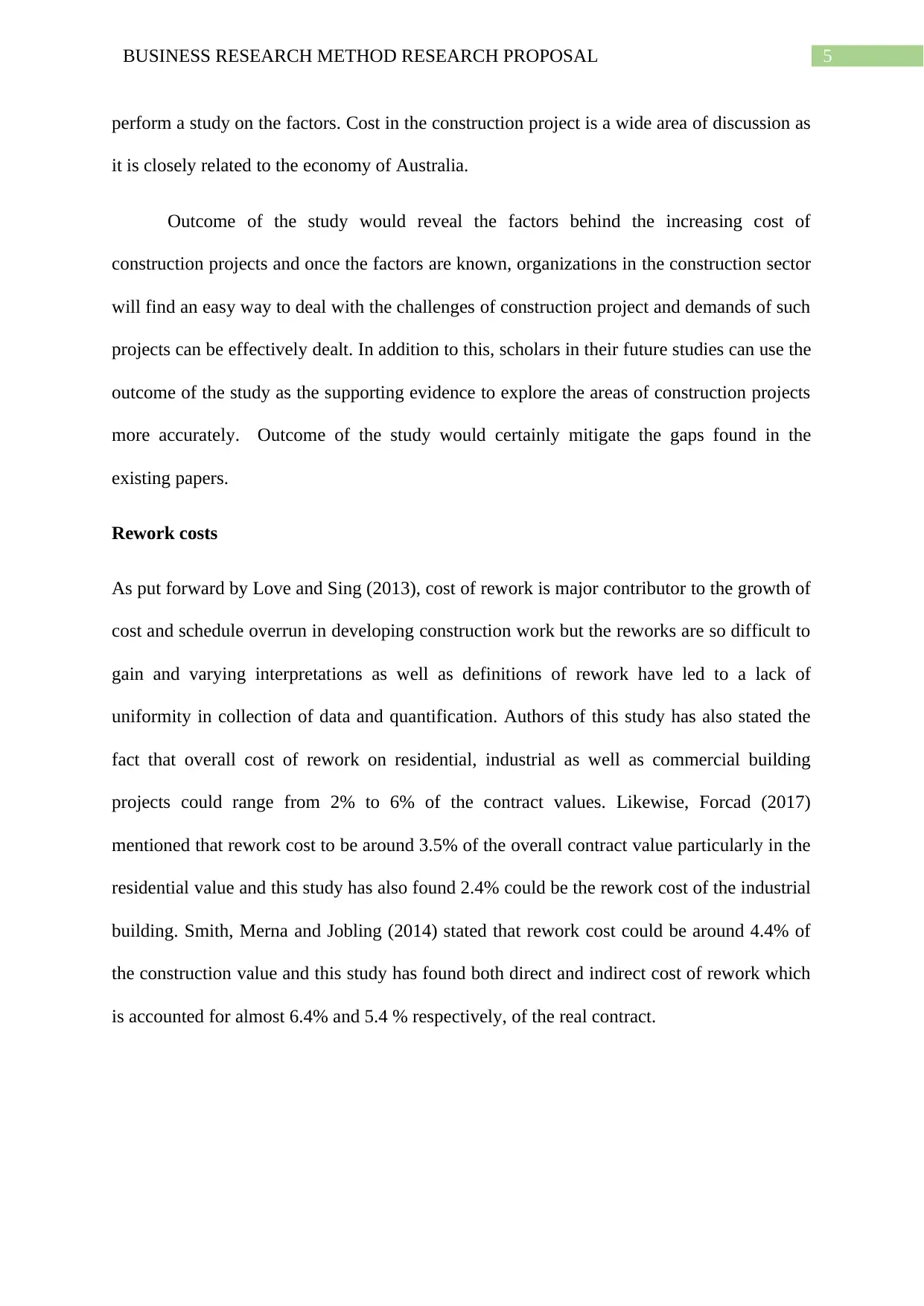
5BUSINESS RESEARCH METHOD RESEARCH PROPOSAL
perform a study on the factors. Cost in the construction project is a wide area of discussion as
it is closely related to the economy of Australia.
Outcome of the study would reveal the factors behind the increasing cost of
construction projects and once the factors are known, organizations in the construction sector
will find an easy way to deal with the challenges of construction project and demands of such
projects can be effectively dealt. In addition to this, scholars in their future studies can use the
outcome of the study as the supporting evidence to explore the areas of construction projects
more accurately. Outcome of the study would certainly mitigate the gaps found in the
existing papers.
Rework costs
As put forward by Love and Sing (2013), cost of rework is major contributor to the growth of
cost and schedule overrun in developing construction work but the reworks are so difficult to
gain and varying interpretations as well as definitions of rework have led to a lack of
uniformity in collection of data and quantification. Authors of this study has also stated the
fact that overall cost of rework on residential, industrial as well as commercial building
projects could range from 2% to 6% of the contract values. Likewise, Forcad (2017)
mentioned that rework cost to be around 3.5% of the overall contract value particularly in the
residential value and this study has also found 2.4% could be the rework cost of the industrial
building. Smith, Merna and Jobling (2014) stated that rework cost could be around 4.4% of
the construction value and this study has found both direct and indirect cost of rework which
is accounted for almost 6.4% and 5.4 % respectively, of the real contract.
perform a study on the factors. Cost in the construction project is a wide area of discussion as
it is closely related to the economy of Australia.
Outcome of the study would reveal the factors behind the increasing cost of
construction projects and once the factors are known, organizations in the construction sector
will find an easy way to deal with the challenges of construction project and demands of such
projects can be effectively dealt. In addition to this, scholars in their future studies can use the
outcome of the study as the supporting evidence to explore the areas of construction projects
more accurately. Outcome of the study would certainly mitigate the gaps found in the
existing papers.
Rework costs
As put forward by Love and Sing (2013), cost of rework is major contributor to the growth of
cost and schedule overrun in developing construction work but the reworks are so difficult to
gain and varying interpretations as well as definitions of rework have led to a lack of
uniformity in collection of data and quantification. Authors of this study has also stated the
fact that overall cost of rework on residential, industrial as well as commercial building
projects could range from 2% to 6% of the contract values. Likewise, Forcad (2017)
mentioned that rework cost to be around 3.5% of the overall contract value particularly in the
residential value and this study has also found 2.4% could be the rework cost of the industrial
building. Smith, Merna and Jobling (2014) stated that rework cost could be around 4.4% of
the construction value and this study has found both direct and indirect cost of rework which
is accounted for almost 6.4% and 5.4 % respectively, of the real contract.
⊘ This is a preview!⊘
Do you want full access?
Subscribe today to unlock all pages.

Trusted by 1+ million students worldwide
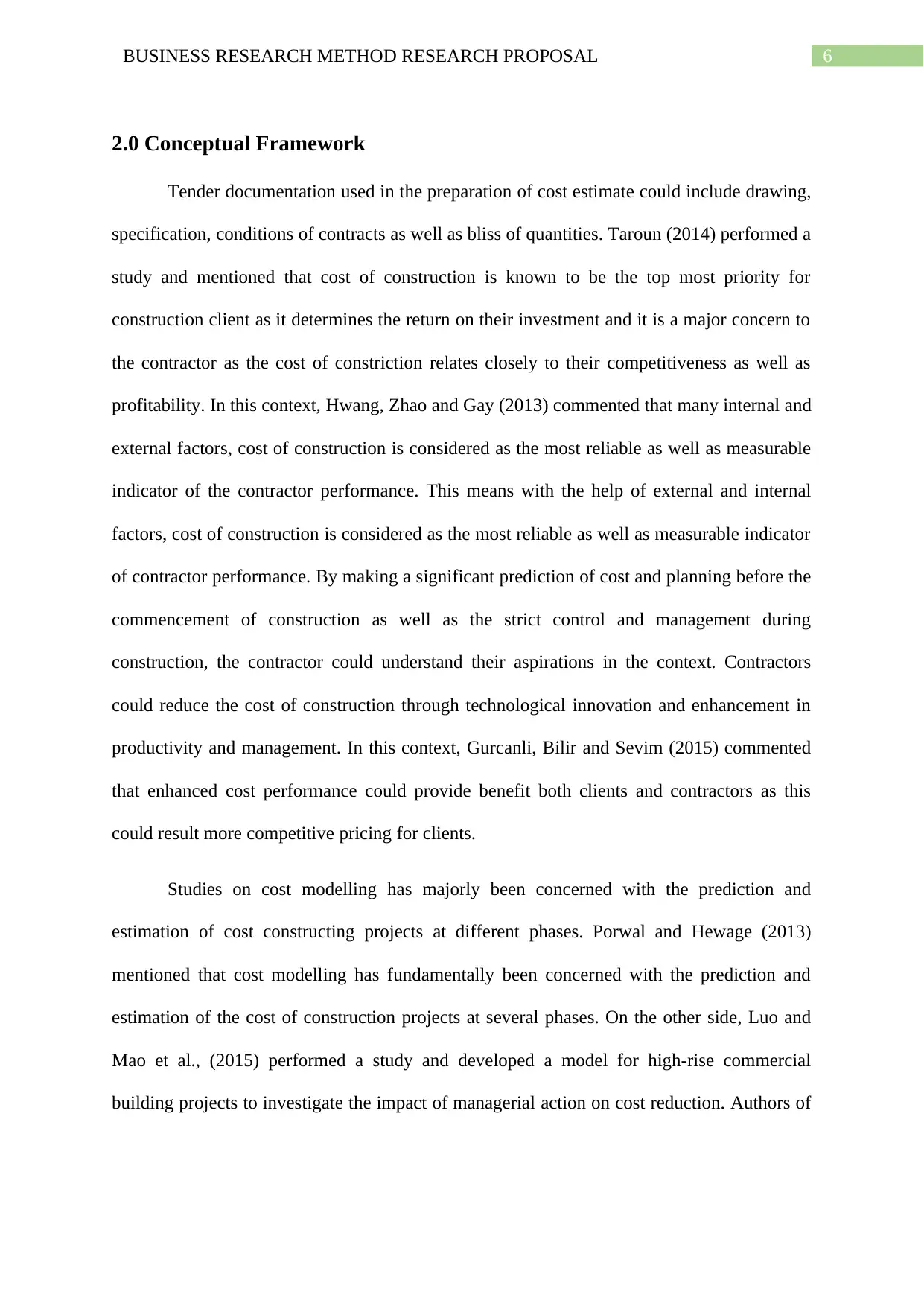
6BUSINESS RESEARCH METHOD RESEARCH PROPOSAL
2.0 Conceptual Framework
Tender documentation used in the preparation of cost estimate could include drawing,
specification, conditions of contracts as well as bliss of quantities. Taroun (2014) performed a
study and mentioned that cost of construction is known to be the top most priority for
construction client as it determines the return on their investment and it is a major concern to
the contractor as the cost of constriction relates closely to their competitiveness as well as
profitability. In this context, Hwang, Zhao and Gay (2013) commented that many internal and
external factors, cost of construction is considered as the most reliable as well as measurable
indicator of the contractor performance. This means with the help of external and internal
factors, cost of construction is considered as the most reliable as well as measurable indicator
of contractor performance. By making a significant prediction of cost and planning before the
commencement of construction as well as the strict control and management during
construction, the contractor could understand their aspirations in the context. Contractors
could reduce the cost of construction through technological innovation and enhancement in
productivity and management. In this context, Gurcanli, Bilir and Sevim (2015) commented
that enhanced cost performance could provide benefit both clients and contractors as this
could result more competitive pricing for clients.
Studies on cost modelling has majorly been concerned with the prediction and
estimation of cost constructing projects at different phases. Porwal and Hewage (2013)
mentioned that cost modelling has fundamentally been concerned with the prediction and
estimation of the cost of construction projects at several phases. On the other side, Luo and
Mao et al., (2015) performed a study and developed a model for high-rise commercial
building projects to investigate the impact of managerial action on cost reduction. Authors of
2.0 Conceptual Framework
Tender documentation used in the preparation of cost estimate could include drawing,
specification, conditions of contracts as well as bliss of quantities. Taroun (2014) performed a
study and mentioned that cost of construction is known to be the top most priority for
construction client as it determines the return on their investment and it is a major concern to
the contractor as the cost of constriction relates closely to their competitiveness as well as
profitability. In this context, Hwang, Zhao and Gay (2013) commented that many internal and
external factors, cost of construction is considered as the most reliable as well as measurable
indicator of the contractor performance. This means with the help of external and internal
factors, cost of construction is considered as the most reliable as well as measurable indicator
of contractor performance. By making a significant prediction of cost and planning before the
commencement of construction as well as the strict control and management during
construction, the contractor could understand their aspirations in the context. Contractors
could reduce the cost of construction through technological innovation and enhancement in
productivity and management. In this context, Gurcanli, Bilir and Sevim (2015) commented
that enhanced cost performance could provide benefit both clients and contractors as this
could result more competitive pricing for clients.
Studies on cost modelling has majorly been concerned with the prediction and
estimation of cost constructing projects at different phases. Porwal and Hewage (2013)
mentioned that cost modelling has fundamentally been concerned with the prediction and
estimation of the cost of construction projects at several phases. On the other side, Luo and
Mao et al., (2015) performed a study and developed a model for high-rise commercial
building projects to investigate the impact of managerial action on cost reduction. Authors of
Paraphrase This Document
Need a fresh take? Get an instant paraphrase of this document with our AI Paraphraser
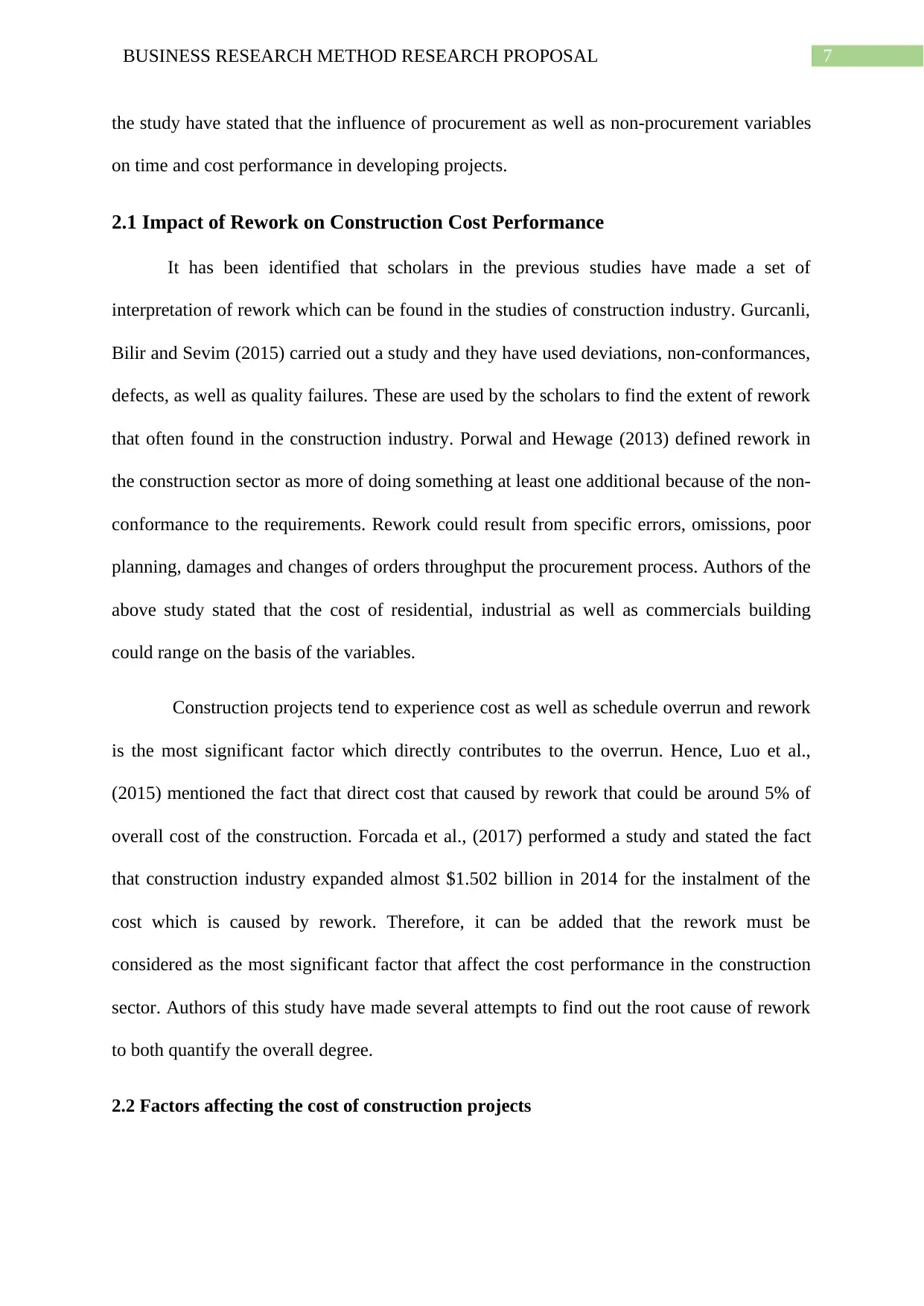
7BUSINESS RESEARCH METHOD RESEARCH PROPOSAL
the study have stated that the influence of procurement as well as non-procurement variables
on time and cost performance in developing projects.
2.1 Impact of Rework on Construction Cost Performance
It has been identified that scholars in the previous studies have made a set of
interpretation of rework which can be found in the studies of construction industry. Gurcanli,
Bilir and Sevim (2015) carried out a study and they have used deviations, non-conformances,
defects, as well as quality failures. These are used by the scholars to find the extent of rework
that often found in the construction industry. Porwal and Hewage (2013) defined rework in
the construction sector as more of doing something at least one additional because of the non-
conformance to the requirements. Rework could result from specific errors, omissions, poor
planning, damages and changes of orders throughput the procurement process. Authors of the
above study stated that the cost of residential, industrial as well as commercials building
could range on the basis of the variables.
Construction projects tend to experience cost as well as schedule overrun and rework
is the most significant factor which directly contributes to the overrun. Hence, Luo et al.,
(2015) mentioned the fact that direct cost that caused by rework that could be around 5% of
overall cost of the construction. Forcada et al., (2017) performed a study and stated the fact
that construction industry expanded almost $1.502 billion in 2014 for the instalment of the
cost which is caused by rework. Therefore, it can be added that the rework must be
considered as the most significant factor that affect the cost performance in the construction
sector. Authors of this study have made several attempts to find out the root cause of rework
to both quantify the overall degree.
2.2 Factors affecting the cost of construction projects
the study have stated that the influence of procurement as well as non-procurement variables
on time and cost performance in developing projects.
2.1 Impact of Rework on Construction Cost Performance
It has been identified that scholars in the previous studies have made a set of
interpretation of rework which can be found in the studies of construction industry. Gurcanli,
Bilir and Sevim (2015) carried out a study and they have used deviations, non-conformances,
defects, as well as quality failures. These are used by the scholars to find the extent of rework
that often found in the construction industry. Porwal and Hewage (2013) defined rework in
the construction sector as more of doing something at least one additional because of the non-
conformance to the requirements. Rework could result from specific errors, omissions, poor
planning, damages and changes of orders throughput the procurement process. Authors of the
above study stated that the cost of residential, industrial as well as commercials building
could range on the basis of the variables.
Construction projects tend to experience cost as well as schedule overrun and rework
is the most significant factor which directly contributes to the overrun. Hence, Luo et al.,
(2015) mentioned the fact that direct cost that caused by rework that could be around 5% of
overall cost of the construction. Forcada et al., (2017) performed a study and stated the fact
that construction industry expanded almost $1.502 billion in 2014 for the instalment of the
cost which is caused by rework. Therefore, it can be added that the rework must be
considered as the most significant factor that affect the cost performance in the construction
sector. Authors of this study have made several attempts to find out the root cause of rework
to both quantify the overall degree.
2.2 Factors affecting the cost of construction projects
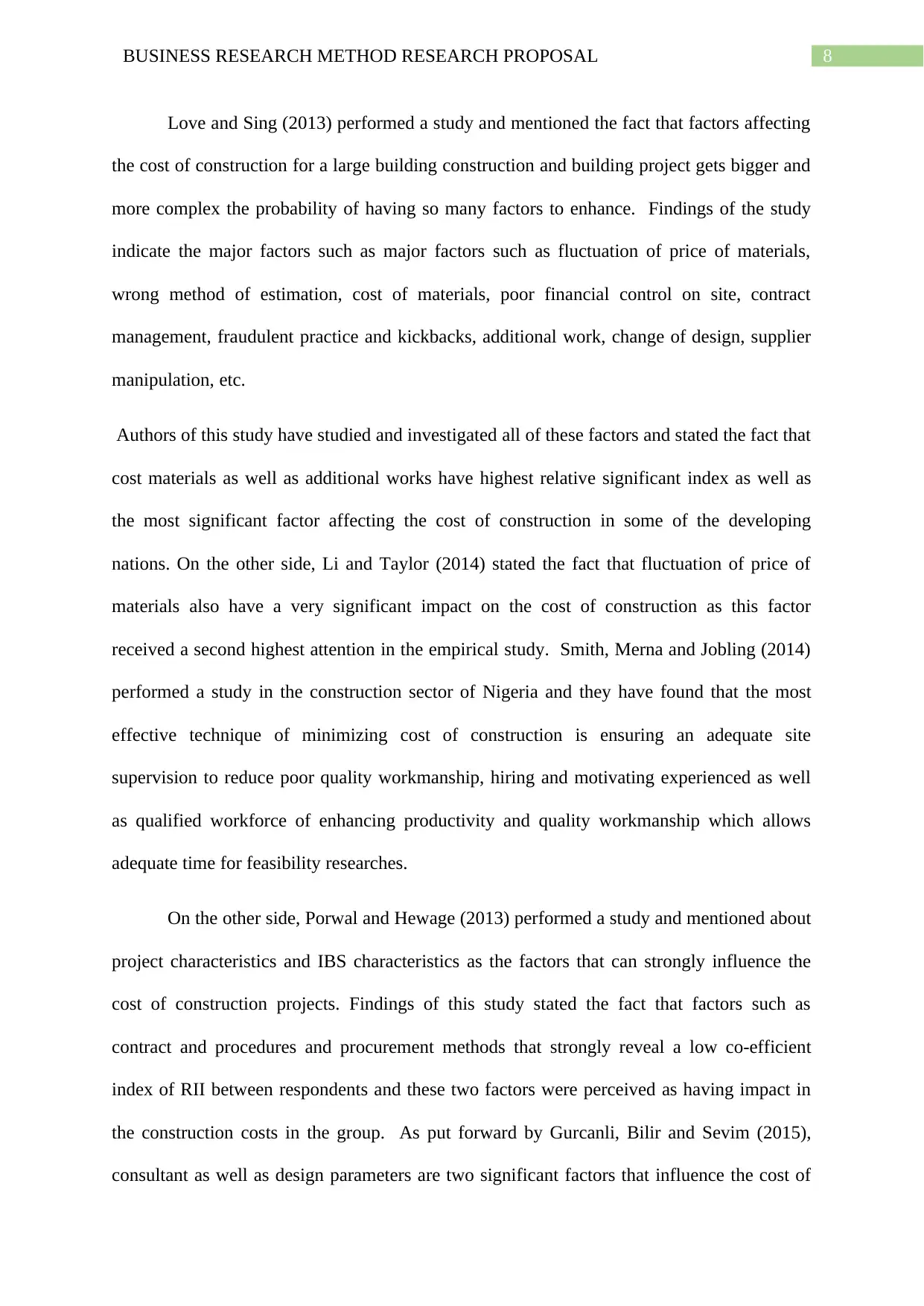
8BUSINESS RESEARCH METHOD RESEARCH PROPOSAL
Love and Sing (2013) performed a study and mentioned the fact that factors affecting
the cost of construction for a large building construction and building project gets bigger and
more complex the probability of having so many factors to enhance. Findings of the study
indicate the major factors such as major factors such as fluctuation of price of materials,
wrong method of estimation, cost of materials, poor financial control on site, contract
management, fraudulent practice and kickbacks, additional work, change of design, supplier
manipulation, etc.
Authors of this study have studied and investigated all of these factors and stated the fact that
cost materials as well as additional works have highest relative significant index as well as
the most significant factor affecting the cost of construction in some of the developing
nations. On the other side, Li and Taylor (2014) stated the fact that fluctuation of price of
materials also have a very significant impact on the cost of construction as this factor
received a second highest attention in the empirical study. Smith, Merna and Jobling (2014)
performed a study in the construction sector of Nigeria and they have found that the most
effective technique of minimizing cost of construction is ensuring an adequate site
supervision to reduce poor quality workmanship, hiring and motivating experienced as well
as qualified workforce of enhancing productivity and quality workmanship which allows
adequate time for feasibility researches.
On the other side, Porwal and Hewage (2013) performed a study and mentioned about
project characteristics and IBS characteristics as the factors that can strongly influence the
cost of construction projects. Findings of this study stated the fact that factors such as
contract and procedures and procurement methods that strongly reveal a low co-efficient
index of RII between respondents and these two factors were perceived as having impact in
the construction costs in the group. As put forward by Gurcanli, Bilir and Sevim (2015),
consultant as well as design parameters are two significant factors that influence the cost of
Love and Sing (2013) performed a study and mentioned the fact that factors affecting
the cost of construction for a large building construction and building project gets bigger and
more complex the probability of having so many factors to enhance. Findings of the study
indicate the major factors such as major factors such as fluctuation of price of materials,
wrong method of estimation, cost of materials, poor financial control on site, contract
management, fraudulent practice and kickbacks, additional work, change of design, supplier
manipulation, etc.
Authors of this study have studied and investigated all of these factors and stated the fact that
cost materials as well as additional works have highest relative significant index as well as
the most significant factor affecting the cost of construction in some of the developing
nations. On the other side, Li and Taylor (2014) stated the fact that fluctuation of price of
materials also have a very significant impact on the cost of construction as this factor
received a second highest attention in the empirical study. Smith, Merna and Jobling (2014)
performed a study in the construction sector of Nigeria and they have found that the most
effective technique of minimizing cost of construction is ensuring an adequate site
supervision to reduce poor quality workmanship, hiring and motivating experienced as well
as qualified workforce of enhancing productivity and quality workmanship which allows
adequate time for feasibility researches.
On the other side, Porwal and Hewage (2013) performed a study and mentioned about
project characteristics and IBS characteristics as the factors that can strongly influence the
cost of construction projects. Findings of this study stated the fact that factors such as
contract and procedures and procurement methods that strongly reveal a low co-efficient
index of RII between respondents and these two factors were perceived as having impact in
the construction costs in the group. As put forward by Gurcanli, Bilir and Sevim (2015),
consultant as well as design parameters are two significant factors that influence the cost of
⊘ This is a preview!⊘
Do you want full access?
Subscribe today to unlock all pages.

Trusted by 1+ million students worldwide
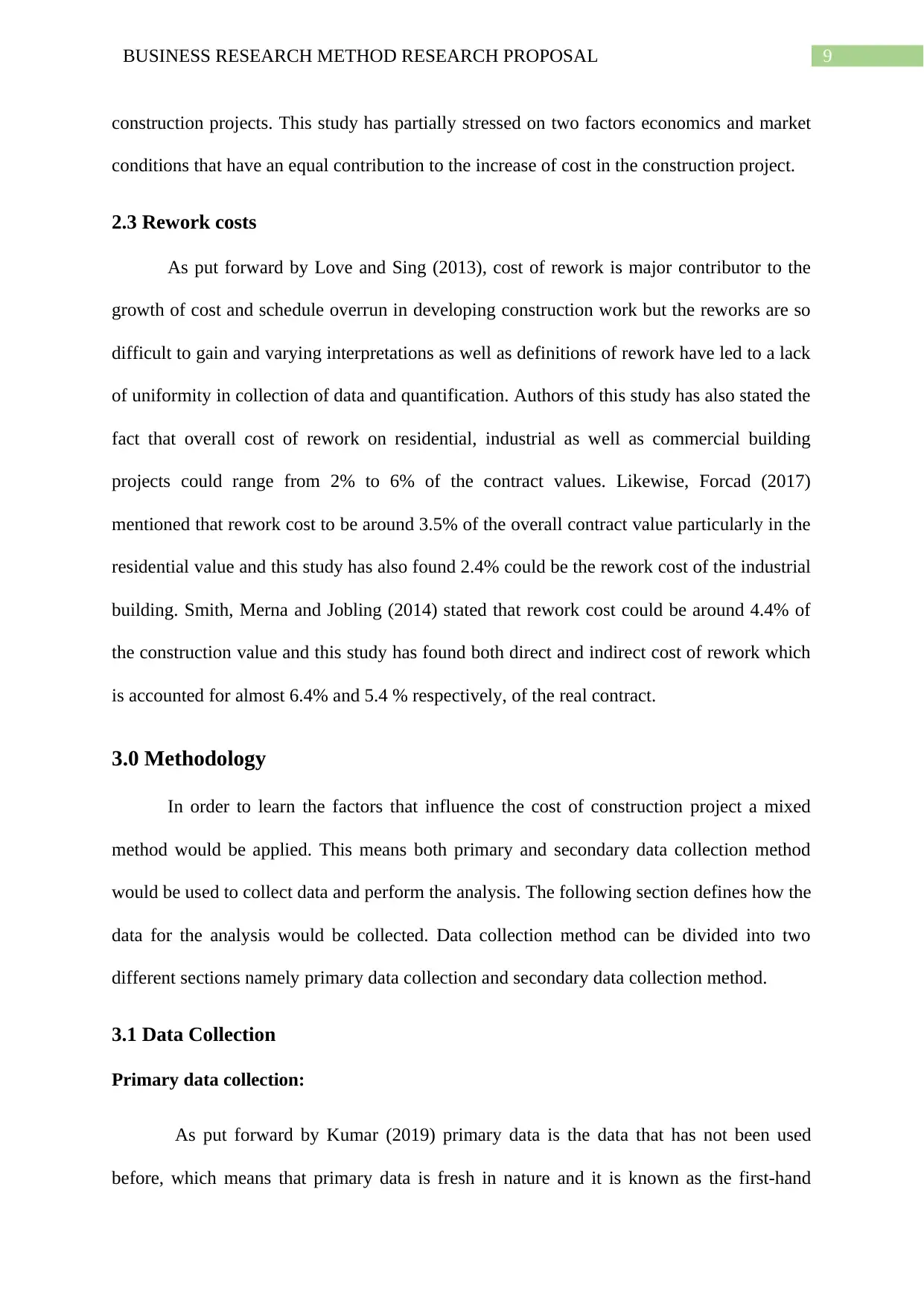
9BUSINESS RESEARCH METHOD RESEARCH PROPOSAL
construction projects. This study has partially stressed on two factors economics and market
conditions that have an equal contribution to the increase of cost in the construction project.
2.3 Rework costs
As put forward by Love and Sing (2013), cost of rework is major contributor to the
growth of cost and schedule overrun in developing construction work but the reworks are so
difficult to gain and varying interpretations as well as definitions of rework have led to a lack
of uniformity in collection of data and quantification. Authors of this study has also stated the
fact that overall cost of rework on residential, industrial as well as commercial building
projects could range from 2% to 6% of the contract values. Likewise, Forcad (2017)
mentioned that rework cost to be around 3.5% of the overall contract value particularly in the
residential value and this study has also found 2.4% could be the rework cost of the industrial
building. Smith, Merna and Jobling (2014) stated that rework cost could be around 4.4% of
the construction value and this study has found both direct and indirect cost of rework which
is accounted for almost 6.4% and 5.4 % respectively, of the real contract.
3.0 Methodology
In order to learn the factors that influence the cost of construction project a mixed
method would be applied. This means both primary and secondary data collection method
would be used to collect data and perform the analysis. The following section defines how the
data for the analysis would be collected. Data collection method can be divided into two
different sections namely primary data collection and secondary data collection method.
3.1 Data Collection
Primary data collection:
As put forward by Kumar (2019) primary data is the data that has not been used
before, which means that primary data is fresh in nature and it is known as the first-hand
construction projects. This study has partially stressed on two factors economics and market
conditions that have an equal contribution to the increase of cost in the construction project.
2.3 Rework costs
As put forward by Love and Sing (2013), cost of rework is major contributor to the
growth of cost and schedule overrun in developing construction work but the reworks are so
difficult to gain and varying interpretations as well as definitions of rework have led to a lack
of uniformity in collection of data and quantification. Authors of this study has also stated the
fact that overall cost of rework on residential, industrial as well as commercial building
projects could range from 2% to 6% of the contract values. Likewise, Forcad (2017)
mentioned that rework cost to be around 3.5% of the overall contract value particularly in the
residential value and this study has also found 2.4% could be the rework cost of the industrial
building. Smith, Merna and Jobling (2014) stated that rework cost could be around 4.4% of
the construction value and this study has found both direct and indirect cost of rework which
is accounted for almost 6.4% and 5.4 % respectively, of the real contract.
3.0 Methodology
In order to learn the factors that influence the cost of construction project a mixed
method would be applied. This means both primary and secondary data collection method
would be used to collect data and perform the analysis. The following section defines how the
data for the analysis would be collected. Data collection method can be divided into two
different sections namely primary data collection and secondary data collection method.
3.1 Data Collection
Primary data collection:
As put forward by Kumar (2019) primary data is the data that has not been used
before, which means that primary data is fresh in nature and it is known as the first-hand
Paraphrase This Document
Need a fresh take? Get an instant paraphrase of this document with our AI Paraphraser
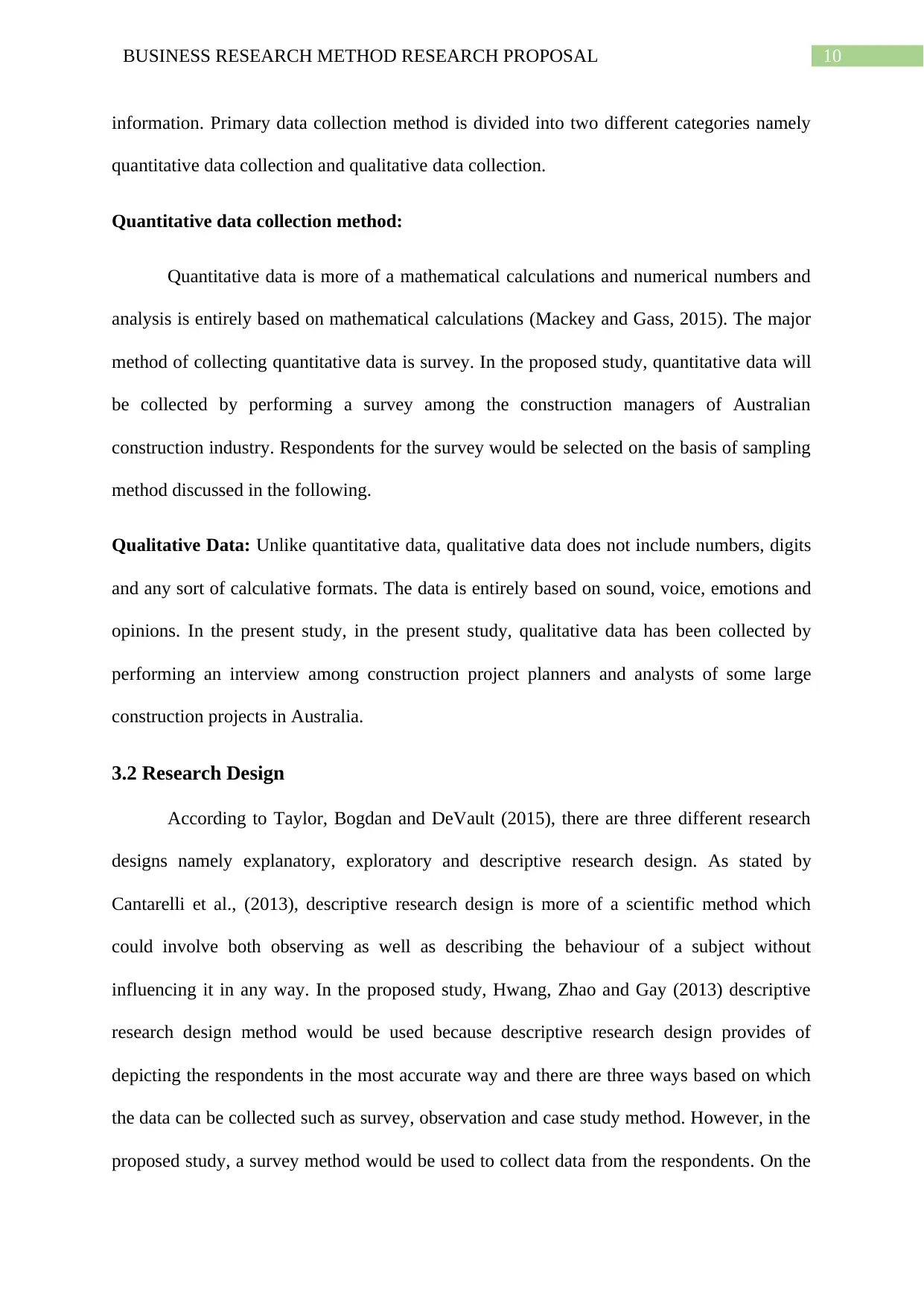
10BUSINESS RESEARCH METHOD RESEARCH PROPOSAL
information. Primary data collection method is divided into two different categories namely
quantitative data collection and qualitative data collection.
Quantitative data collection method:
Quantitative data is more of a mathematical calculations and numerical numbers and
analysis is entirely based on mathematical calculations (Mackey and Gass, 2015). The major
method of collecting quantitative data is survey. In the proposed study, quantitative data will
be collected by performing a survey among the construction managers of Australian
construction industry. Respondents for the survey would be selected on the basis of sampling
method discussed in the following.
Qualitative Data: Unlike quantitative data, qualitative data does not include numbers, digits
and any sort of calculative formats. The data is entirely based on sound, voice, emotions and
opinions. In the present study, in the present study, qualitative data has been collected by
performing an interview among construction project planners and analysts of some large
construction projects in Australia.
3.2 Research Design
According to Taylor, Bogdan and DeVault (2015), there are three different research
designs namely explanatory, exploratory and descriptive research design. As stated by
Cantarelli et al., (2013), descriptive research design is more of a scientific method which
could involve both observing as well as describing the behaviour of a subject without
influencing it in any way. In the proposed study, Hwang, Zhao and Gay (2013) descriptive
research design method would be used because descriptive research design provides of
depicting the respondents in the most accurate way and there are three ways based on which
the data can be collected such as survey, observation and case study method. However, in the
proposed study, a survey method would be used to collect data from the respondents. On the
information. Primary data collection method is divided into two different categories namely
quantitative data collection and qualitative data collection.
Quantitative data collection method:
Quantitative data is more of a mathematical calculations and numerical numbers and
analysis is entirely based on mathematical calculations (Mackey and Gass, 2015). The major
method of collecting quantitative data is survey. In the proposed study, quantitative data will
be collected by performing a survey among the construction managers of Australian
construction industry. Respondents for the survey would be selected on the basis of sampling
method discussed in the following.
Qualitative Data: Unlike quantitative data, qualitative data does not include numbers, digits
and any sort of calculative formats. The data is entirely based on sound, voice, emotions and
opinions. In the present study, in the present study, qualitative data has been collected by
performing an interview among construction project planners and analysts of some large
construction projects in Australia.
3.2 Research Design
According to Taylor, Bogdan and DeVault (2015), there are three different research
designs namely explanatory, exploratory and descriptive research design. As stated by
Cantarelli et al., (2013), descriptive research design is more of a scientific method which
could involve both observing as well as describing the behaviour of a subject without
influencing it in any way. In the proposed study, Hwang, Zhao and Gay (2013) descriptive
research design method would be used because descriptive research design provides of
depicting the respondents in the most accurate way and there are three ways based on which
the data can be collected such as survey, observation and case study method. However, in the
proposed study, a survey method would be used to collect data from the respondents. On the
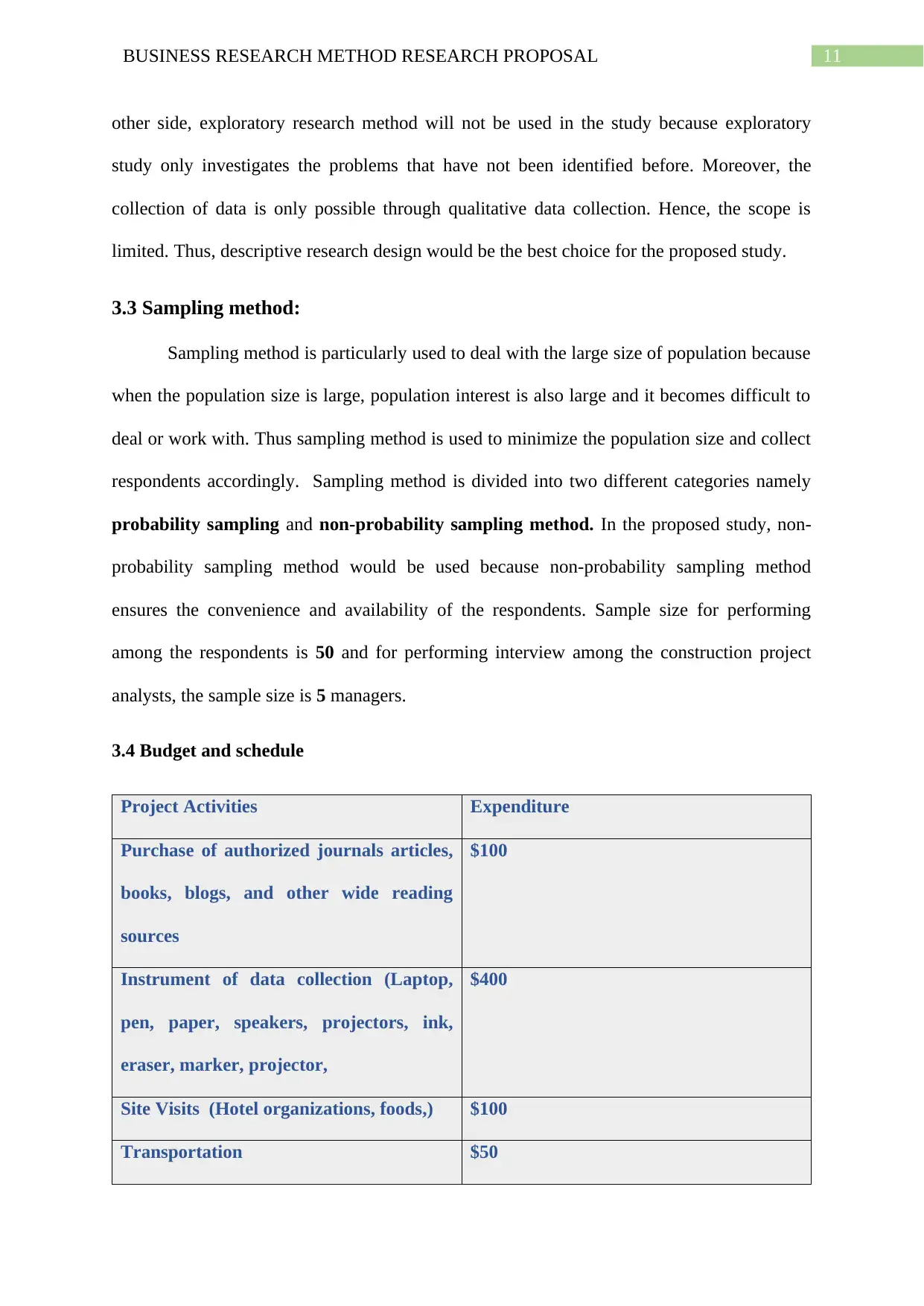
11BUSINESS RESEARCH METHOD RESEARCH PROPOSAL
other side, exploratory research method will not be used in the study because exploratory
study only investigates the problems that have not been identified before. Moreover, the
collection of data is only possible through qualitative data collection. Hence, the scope is
limited. Thus, descriptive research design would be the best choice for the proposed study.
3.3 Sampling method:
Sampling method is particularly used to deal with the large size of population because
when the population size is large, population interest is also large and it becomes difficult to
deal or work with. Thus sampling method is used to minimize the population size and collect
respondents accordingly. Sampling method is divided into two different categories namely
probability sampling and non-probability sampling method. In the proposed study, non-
probability sampling method would be used because non-probability sampling method
ensures the convenience and availability of the respondents. Sample size for performing
among the respondents is 50 and for performing interview among the construction project
analysts, the sample size is 5 managers.
3.4 Budget and schedule
Project Activities Expenditure
Purchase of authorized journals articles,
books, blogs, and other wide reading
sources
$100
Instrument of data collection (Laptop,
pen, paper, speakers, projectors, ink,
eraser, marker, projector,
$400
Site Visits (Hotel organizations, foods,) $100
Transportation $50
other side, exploratory research method will not be used in the study because exploratory
study only investigates the problems that have not been identified before. Moreover, the
collection of data is only possible through qualitative data collection. Hence, the scope is
limited. Thus, descriptive research design would be the best choice for the proposed study.
3.3 Sampling method:
Sampling method is particularly used to deal with the large size of population because
when the population size is large, population interest is also large and it becomes difficult to
deal or work with. Thus sampling method is used to minimize the population size and collect
respondents accordingly. Sampling method is divided into two different categories namely
probability sampling and non-probability sampling method. In the proposed study, non-
probability sampling method would be used because non-probability sampling method
ensures the convenience and availability of the respondents. Sample size for performing
among the respondents is 50 and for performing interview among the construction project
analysts, the sample size is 5 managers.
3.4 Budget and schedule
Project Activities Expenditure
Purchase of authorized journals articles,
books, blogs, and other wide reading
sources
$100
Instrument of data collection (Laptop,
pen, paper, speakers, projectors, ink,
eraser, marker, projector,
$400
Site Visits (Hotel organizations, foods,) $100
Transportation $50
⊘ This is a preview!⊘
Do you want full access?
Subscribe today to unlock all pages.

Trusted by 1+ million students worldwide
1 out of 16
Related Documents
Your All-in-One AI-Powered Toolkit for Academic Success.
+13062052269
info@desklib.com
Available 24*7 on WhatsApp / Email
![[object Object]](/_next/static/media/star-bottom.7253800d.svg)
Unlock your academic potential
Copyright © 2020–2025 A2Z Services. All Rights Reserved. Developed and managed by ZUCOL.





